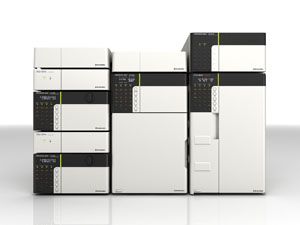Method Scouting Solution
Since the introduction of UHPLC, strategies for fast method development are being discussed. A wide variety of columns with different separation properties is available, offering the user a number of columns suited to a specific application.

Since the introduction of UHPLC, strategies for fast method development are being discussed.
A wide variety of columns with different separation properties is available, offering the user a number of columns suited to a specific application. To automate this evaluation step and get quick information about the best column and mobile phase, different strategies have been applied.
The Nexera Method Scouting system has been designed to be used for fast and simple screening of possible combinations of columns and mobile phases. The two pumps in the binary gradient system are therefore equipped with quaternary gradient capabilities for the aqueous and organic solvents supporting solvent blending on each of the pumps. To handle a number of columns, the system has a selection valve which allows a maximum of six columns to be chosen in a scouting process. The photodiode array of MS detectors can be used in combination with the system.
To support the complex and time consuming process of method development and sequence setup, special software is applied on top of the LabSolutions software. A simple user interface allows a fast setup of the method, column selection and adaptation of the gradient profile and analysis time. Global system parameters such as rinse volume and column and solvent database are set once at the beginning, and can be selected afterwards by a tick box.
For data analysis, features of the standard software such as the data browser can be used for a fast and simple overview of the result. A pre-selection is done according to the number of separated peaks. For a more detailed look at the results – a specially designed Agent Report is available.
To offer a complete solution, the Method Scouting can be combined with the dedicated
DryLab® 4 software for Method Optimisation to get a clear picture of method details and optimal separation conditions and the robust space. If a complete method validation should be the result of all investigations, the Validat ® software can be linked to the LabSolutions software and performs the necessary calculations while delivering all results in compliance with the regulations.
For more information please visit www.shimadzu.eu
DryLab® 4 is a registered trademark of Molnar Institute of Applied Chromatography
Validat ® is a registered trademark of iCD
The Complexity of Oligonucleotide Separations
January 9th 2025Peter Pellegrinelli, Applications Specialist at Advanced Materials Technology (AMT) explains the complexity of oligonucleotide separations due to the unique chemical properties of these molecules. Issues such as varying length, sequence complexity, and hydrophilic-hydrophobic characteristics make efficient separations difficult. Separation scientists are addressing these challenges by modifying mobile phase compositions, using varying ion-pairing reagents, and exploring alternative separation modes like HILIC and ion-exchange chromatography. Due to these complexities, AMT has introduced the HALO® OLIGO column, which offers high-resolution, fast separations through its innovative Fused-Core® technology and high pH stability. Alongside explaining the new column, Peter looks to the future of these separations and what is next to come.
Metabolomics Analysis of Low Birth-Weight Infants Using UHPLC-MS/MS Following Lipid Emulsion
January 10th 2025A recent study aimed to directly compare the changes in serum metabolites among very low birth-rate (VLBW) infants following the administration of the soybean oil-based lipid emulsion and soybean oil, medium-chain triglycerides, olive oil, and fish oil (SMOF) lipid emulsion using untargeted metabolomics techniques.
Analyzing New Drug Modalities: An ISC 2024 Interview with Kelly Zhang
January 10th 2025At ISC 2024 in Liverpool, United Kingdom, LCGC International interviewed Kelly Zhang of Genentech about her work analyzing new drug modalities, such as mRNA, oligonucleotides, peptides, and cell and gene therapies.